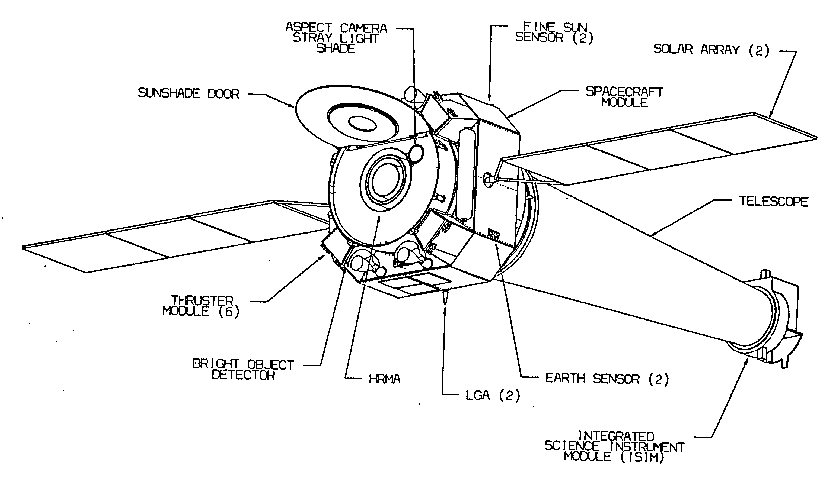 AXAF Deployed
AXAF DeployedThe 1.2 m High Resolution Mirror Assembly (HRMA) is the heart of the observatory.
(LGA: Low-Gain Antenna)
The preparation of AXAF ("Advanced X-ray Astrophysics Facility") for launch in January 1999 on shuttle mission STS-93 is nearly complete, with delivery from the spacecraft contractor TRW to NASA scheduled for late August. AXAF is the third of NASA's "Great Observatory" series, after Hubble Space Telescope (HST) and the Compton Gamma-Ray Observatory. It is the first major US X-ray astronomy mission since the old HEAO 2 (later "Einstein") was launched in 1978. Einstein was the first large X-ray mission to use focusing optics, and thereby achieved a factor of about 1000 times better sensitivity than any previous experiment, along with about 4" (arcsec) angular resolution. But since the revolutionary abundance of Einstein, 20 years of drought have passed. Space shuttles have flown, exploded, and flown again, missions have explored Venus, Mars, and Jupiter, graduate students have grayed into their fifties, with no new NASA X-ray mission. AXAF should achieve a sensitivity 100 times better than Einstein, angular resolution of 0.5", along with parallel improvements in spectroscopic capability, and is likely to remain operable for 10 years. It will advance X-ray astronomy by similar factors to those which HST achieved for optical astronomy. Thus the eagerness of the X-ray community for AXAF, as one foretold since the early 1980's, may be appreciated.
 AXAF Deployed
AXAF DeployedThe most technically challenging feature of AXAF is its X-ray mirror system, fabrication of which alone accounted for about 20% of the $1,400 million dollar cost of the program. X-rays cannot be reflected by ordinary materials at ordinary angles of incidence, so AXAF relies on grazing angles of less than one degree. An immediate consequence is that the total area of the mirrors must be on the order of 100 times larger than their projected area (about 1000 cm²) perpendicular to the viewing axis. The 1.2 m dia. primary is in what is known as a "Woltjer type-1" configuration. Imagine a set of four hollow glass cylinders, each slightly tapered, concentrically nested within one another. The inner surfaces are accurately parabolic, and coated with a layer of iridium polished to a maximum roughness of 3Â RMS -- ie, deviations from perfect smoothness are roughly the size of an atom. A second similar set of four nested hyperbolas follow immediately, and by a second reflection reduce the focus to 10 meters. Great care has been taken in the design and construction, so that the mirrors are effective up to 10 keV. The result is an X-ray reflecting telescope with a superficial resemblance to a 1.2 m, f/10 refractor.
The eight large cylinders of low-expansion glass (total mass about 1000 kgm) are mounted to survive the stresses and vibration of launch, and still hold sub-arc second alignment in the thermal environment of space. As was the case with HST, the optics had to be built, aligned, and tested on Earth, but must operate under zero-g conditions. But unlike HST, AXAF's orbit is too high for the space shuttle to reach, so there will be no second chance to fix it in the awful event of a mistake.
One of AXAF's two major instruments is truly revolutionary, the AXAF CCD Imaging Spectrometer. The charge-coupled devices (CCD's) in the ACIS provide imaging just as optical CCD's do; but at the low count rates characteristic of AXAF, each photon is separately detected and its energy is measured, to typically 2%. Thus ACIS approaches the dream of an ideal astronomical detector: a fully 3 dimensional photon-counting instrument, with 2-dimensional imaging and simultaneous spectroscopy at each point of the image. AXAF also carries a microchannel-plate High-Resolution Camera (HRC), and two transmission gratings that can be used with either focal plane instrument, ACIS or HRC, to give spectral resolutions (E/dE) of up to 2000. The orbit chosen for AXAF, a 10,000 km by 140,000 km ellipse, will have a 60 hr period, allowing long, 48 hr uninterrupted observations of sources, free of interference from the Earth or the radiation belts. Including the 5600 kgm observatory and the 13,900 kgm upper stage, the total launch mass of 22,590 kgm, and the 17.25 m length, uses virtually all of the launch capability of the shuttle Columbia.
Of course we can only guess at what AXAF may reveal, and note some of the obvious implications of its power. Besides having the capability to detect eg, most of the ~300 stars in the Pleiades cluster, it should also observe individual O and RS CVn stars in the Magellanic Clouds, probably hundreds of supernova remnants in M-31, and individual stellar binary X-ray sources in Cen A and the Virgo Cluster. Its ability to image to the relatively high energy of 10 keV will permit it to look deep into the heavily obscured regions surrounding the accretion disks of the supermassive black holes that are probably the "central engines" of active galaxies. With its imaging and spectroscopic capabilities, the characteristic ~7 keV iron line emission of hot interstellar gas will allow AXAF to measure redshifts of galaxies and clusters directly, and map the distribution of both luminous and dark matter from its velocity dispersion, determined from the measured width of the ubiquitous Fe. By observing quasars and active galaxies to great distances, AXAF should help to resolve what is probably a major contribution to the strong cosmic X-ray background.
"Great Observatory" is certainly a pretentious term, but few would deny that Hubble has fully lived up to it. Like HST, AXAF shows every promise of being a scientific landmark, a monument to the energy and devotion of those who conceived it, fought for it, and carried it through.